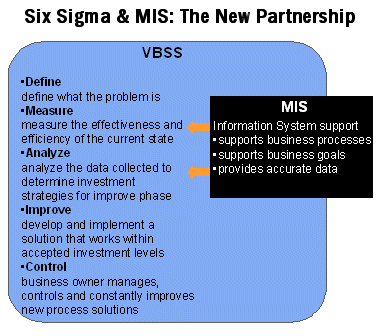
As an outsider to the Six Sigma world, I am immediately astounded at how quickly Six Sigma can change the culture of a company. As a technology consultant, I assist with some Six Sigma projects at a Fortune 500 company. My involvement in Six Sigma projects evolved over time as the head of Six Sigma, the head of MIS (Management of Information Systems), and I began to realize how Six Sigma and MIS provide tremendous value to each other.
MIS relies on business units having well-defined business objectives and business processes. With objectives and processes well defined and documented, MIS can design information systems to support the business units. Six Sigma helps business units define their business processes and goals. MIS, in turn, designs information systems that help Six Sigma initiatives continually improve business processes.
How?
At my client site Six Sigma projects move quickly through various business processes arriving at a narrowly defined solution, in order to meet a specific timeline, generally 3 months. Six Sigma projects use the DMAIC (Define-Measure-Analyze-Improve-Control) method for improving inefficient processes. The DMAIC process is an effective tool for analyzing processes. Of course, the organization should analyze whether the processes evaluated effectively support the business goals of the organization. The DMAIC tool analyzes efficiency more than effectiveness.

Define
A small group of knowledgeable and accountable workers determine what the current problem is. They develop a list of Critical to Quality (CTQ) items for the customer(s).
Measure
This small group then attempts to measure the efficiency of the process and, at times, the effectiveness of the process.
Analyze
The small group then analyzes the data collected to determine how inefficient or ineffective the process may be.
Improve
The group then determines what the best solution is under the constraints of time and money.
Control
The group documents the improvement process and strategies for controlling the process improvements. The business owner, who will manage the process going forward, will have documentation and a methodology to control and constantly improve the process.
The DMAIC process relies heavily on accurate information getting collected within the measurement and analysis phases. Information systems support plays an integral role in the measurement and analysis of processes. Often there are no information systems to support the measurement and analysis phases of Six Sigma projects. Even if there are information systems to support the DMAIC process, the data integrity can be called into question if the process relies heavily on manual data entry. This lack of data integrity obfuscates the Analysis phase, as the Six Sigma team does not have complete confidence in the data. This will affect investment decisions in the Improvement phase.
Data Integrity Example
Receiving docks get inventory and data-enter the information into a system. If this information is typed into an inventory system and then tracked through storage or the manufacturing process with manual entry, there are opportunities for error. A more effective system would utilize scanners for tracking the movement of assets within manufacturing process. If measuring and analyzing the manual entry process, a Six Sigma team would have to take into account that there are some inaccuracies inherent with manual data entry.
Conclusion
Six Sigma initiatives will increasingly focus their solutions on information systems, creating a foundation for increased cooperation with Information Technology departments. With a strong partnership between Six Sigma and IT, organizations can make more informed investment decisions about process improvement projects.